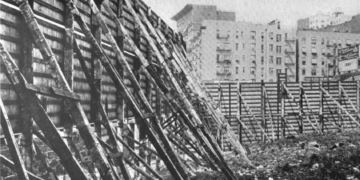
By Julia Zichello
Tree pits, or beds, the rectangular patches of earth surrounding New York City’s street trees, function as a reflection of the hyper-local street culture and community. And like the city itself, they are intensely varied and dynamic.
These plots are filled with everything from the best intentions to the butts of cigarettes, begonias, bottlecaps, rocks from somewhere, rats out of nowhere, and stories only the trees could tell.
Officially, the tree beds are the property of the New York City Department of Parks and Recreation, but unofficially, they belong to everyone and to no one. Building maintenance, generous volunteers, and local organizations work to remove trash, plant flowers, and tend to these miniature gardens. These beds can be a daily reminder of all that is good and beautiful in the world, but like an epic story or a classic fable, there is also often conflict, disappearing-reappearing villains, twist-ties and turns, and if you are lucky — a wise old tree.
There are 11,471 recorded street trees between West 110th and 59th streets, according to the interactive New York City Tree Map. Street trees provide essential shade, CO2 sequestration, absorption for rainfall, perches for birds and insects, and that special sense of tranquility which only leaves twirling in a gentle breeze seem to bring. But the beds themselves tell a different kind of story, something richer, weirder even, more human.

At my corner, there’s a tree bed which I would refer to as a “pit.” But not a pit of despair, more like an archeological pit. No emotions, just artifacts. This tree pit acts as a receptacle for the human activities that occur at that intersection. Often, a group of people stand at the corner chatting and drinking beer.
Occasionally, on sunny summer Saturdays, they pull up chairs and play music. The whole scene seems to say, “the sun is shining, the world is hopping, and beers are popping!”
Other days dominoes are played, which is quieter (but not always!). This flurry of activity has been occurring for over 20 years, a very long-running sidewalk party. As a result, in the nearest tree pit there are bottlecaps, many of them, mostly Corona, Heineken, and Coors, which tell a simple story of a group of people drinking beer. (And which also happens to be one of the oldest human drinking stories; beer was the first recorded human-made beverage, some 7,000 years ago).
Archeologists seek to contextualize the cultural materials which they find, so: Was it a party? Who was there? How many people? When? But all the retrospective analysis in the world cannot bring back certain human activities. This tree pit doesn’t quite capture every aspect of the observable human behaviors, like laughter, companionship, and the buzzy spontaneity of a place to be to watch the world go by. Those sentiments are truly lost in tiny bubbles of time.
Tree pits are similar to the “test-pit” technique used by archeologists: one-meter square plots measured out for a systematized excavation process. Archeologists dig down a few centimeters and assign the sediment and artifacts to a specific layer for later analysis. The recovered artifacts are not a complete record of what was once there, but a biased record of the types of materials which preserve over time. Which makes me wonder, what will the tree pits say about the very specific locations in which we live, many years after we are gone? Pop! Drop. Clink. Smirk. Slurp. Repeat. Night falls. Sun rises — and only the bottlecaps remain.

Recently, I whooshed around my corner and noticed that the party pit had been modified. Wait—what?! A local community organization cleared out all of the trash, installed mulch, and planted flowers. Impatiens. Wow. I was surprised. I had grown accustomed to the bottlecaps. The archeological “data” was erased, but I am happy for the tree, and the cycle of removal and renewal is part of the story too.
What’s the story in your tree pit? See a sampling of some tree pits throughout the neighborhood below.
Julia Zichello is an evolutionary biologist living on the Upper West Side.






Julia Zichello, Ph.D. is an evolutionary biologist living on the Upper West Side.
Subscribe to West Side Rag’s FREE email newsletter here. And you can Support the Rag here.









If only dog owners would keep their dogs out of tree beds……..if only.
Our tree pits need to be expanded due to tree over growth of roots. We keep getting quotes north of $10k to remove bricks and level the dirt. Since they are on the street side a permit is required. Of anyone has a reputable vendor lmk rkudyba ( at ) Yahoo dot com
Sent you an email. If anyone else is interested in exploring expanding their tree bed(s), go to https://www.nycgovparks.org/services/forestry/sidewalk-repair.
Only on the UWS would someone romanticize what sounds like a regular public nuisance and the littering of public green space.
I feel stupider for having read this.
I get the impression that would not take much, no matter what you read.
I encourage everyone to adopt a tree bed or “pit”. Many existing tree beds have been trashed or are barren. A lot of new trees have been planted which have no fencing or plantings. Think of it as your personal little garden. My adopted tree bed on W 86 St gives me pleasure every time I walk past it. It doesn’t take much money or work to beautify one little square at a time.
I am somewhat obsessed with our tree beds. What pisses me off is when commercial businesses use it to house their garbage cans. It is disgusting and businesses should be fined.
The buildings in front of the beds should be responsible for maintaining and planting in the beds.
The Riverside Park Conservancy has an ongoing campaign to fill 120 empty tree pits along Riverside Drive. In 2024 funds were raised to plant 65 trees. The remaining 55 will hopefully be sponsored and installed in December during planting season. Our building along with private donors planted 10 trees. They are thriving! I personally planted one tree which I see every day! Please visit: https://riversideparknyc.org/more-trees to learn more about this ambitious and forward thinking program. And make a contribution on the spot!
Tree pits, should be used for Affordable Housing
What is WRONG with you?
this is a very tasteless joke
Yawn
The common denominator for UWS tree beds is dog pee/poop. Humans are not very intelligent. Somehow they figure we’ll be able to live off dog pee/poop one day instead of the oxygen that the trees (that the dog waste is killing) provide. All the money spent on cutesy signs “kowtowingly” pleading with the ‘owners’ (entitled selfish people) to control the dogs — that money would be better used to plant more trees. It’s not rocket science — just CUT THE CRAP. Trees — not dogs — provide true unconditional love. But, oh well, humans are the most selfish animals, so it’s a hopeless cause.
Agree with this comment / saw a dad with two young sons and his dog doing its business in tree well / also a lady with dog -/ same deal – when I glared at her she laid into me with a “Can I help you …” and inexplicably defended her actions- the level of dog ownership entitlement is off the charts -can’t these owners do better?
The tree pits on Broadway (west side of street) between 96-97 are dangerous; they have no guard rails and I (a very spry 70-yr-old) fell into one in the dark of early evening several months ago and came up with a bloody knee and a broken phone……. the lighting is bad there as well on that SW corner, and without tree guards or railings it’s easy to walk into one where the side walk narrows to create some weird parking lane for ???? Please consider adding these tree guard railings in this area, not just side streets, because I can’t be the only only to have had an encounter like this there. It IS a crowded sidewalk, and everyone is in a hurry or reading their phones as they walk, so it’s quite treacherous. Tree guards would help.
“Tree Pits of the Upper West Side”. Would the Rag consider featuring readers’ submissions for a monthly feature?
Dog urine also corrodes brick, concrete,metal and paint. I see evidence of this on most every building foundation I have ever walked past. I have seen only one woman “curbing” her dog in the last 8 weeks. And if there are cars parked along the curbs?…..well I did mention paint corrosion. May we should start training dogs to use litter boxes instead of corroding our world.
Nice read! We are familiar with all the stuff that ends up in tree beds—too much for our efforts to green a neighborhood and a borough desperately short of park space so we seek out all sorts of left over spaces. A story about our story.
https://www.cbsnews.com/newyork/news/city-tree-beds-get-tlc-from-volunteer-new-yorkers/
We live in a city.
To coexist, keep dogs out of flower beds and pick up turds.
Other than that? Dogs pee. Wherever they want. And tree beds are great places to pee.
If you want a lawn move to the suburbs.
Street tree pits are a part of NYC Parks, as mentioned above. There is an organization that addresses street trees specifically, Trees NY. They also offer the Citizen Pruner course, which teaches basic pruning techniques and tree care, street tree identification, and tree pit maintenance. I’ve been a volunteer in NYC Parks (currently Riverside Park) for 34 years, and the original Citizen Pruner course has really helped me throughout. I recommend it to anyone interested in taking care of the trees on your block or neighborhood, or your own backyard.
The tree died in front of our building and they cut it down. Does anyone know who to contact to request a new tree be planted? I submitted a case to 311 but they closed it without explanation.